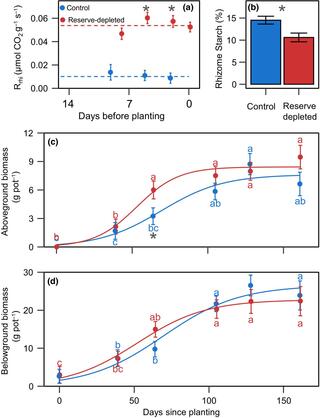A 30% reduction in switchgrass rhizome reserves did not decrease biomass yield
M.Tejera-Nieves and B.J. Walker "A 30% reduction in switchgrass rhizome reserves did not decrease biomass yield" Global Change Biology – Bioenergy 15:1329 (2023) [DOI: 10.1111/gcbb.13094]
A long-standing question in perennial grass breeding and physiology is whether yield improvement strategies could compromise winter survival. Since perennial grasses rely on stored carbohydrates for winter maintenance and spring regrowth, yield improvement strategies could reduce winter survival if they increase biomass and grain yields at the expense of carbon allocation to storage. Therefore, it is crucial to comprehend the dependence of regrowth on storage reserves. We experimentally depleted switchgrass (Panicum virgatum L.) rhizome reserves by storing rhizomes for 2 weeks at 5°C (control treatment) and 25°C (reserve-depleted treatment). During the storage period rhizome respiration was 5.3× higher at 25°C (0.010 μmol CO2 g−1 min−1 at 5°C vs. 0.054 μmol CO2 g−1 min−1 at 25°C; p < 0.0001) and the starch content was depleted by 30% by the end of storage. Surprisingly, reserve-depleted switchgrass had 60% larger leaf area (LA; LAcontrol = 149 cm2 pot−1 vs. LAdepleted = 239 cm2 pot−1; p = 0.013) and produced ~40% more aboveground biomass than control plants (9.46 g pot−1 vs. 6.63 g pot−1; p = 0.112). In addition, reserve-depleted switchgrass restored its rhizome starch reserves to pre-storage levels. Switchgrass showed a large plasticity among its source-sink components to buffer the imposed reserve depletion. It increased plant photosynthesis by increasing the photosynthetic leaf area while keeping photosynthesis constant on a leaf area basis and readjusted the timing and activity of sink organs. These results suggest that switchgrass, and potentially other perennial grasses, largely over-invest in storage reserves. Therefore, current breeding strategies in perennial grasses aimed to extend the aboveground growing season should not compromise crop persistence. Our study also has implications on long-term yield dynamics as it highlights sink limitations as potential driver of the yield decline commonly observed in perennial grasses 5+ years after cultivation.
All primary data to support the findings of this study are openly available in Dryad at https://doi.org/10.5061/dryad.4b8gthtj1. Scripts are available at: https://github.com/PerennialDr/SinkDepletion
